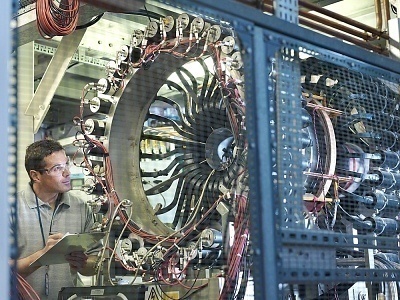Particle Detector
Most particle detectors are used in applied particle physics, nuclear physics, and nuclear engineering. Most particle detectors measure the momentum, spin, charge, etc. of high energy particles. This is integral to the study of the particles, their sources, and any observable actions.
Particle detectors can be very large and can produce a wide range of results depending on their main mode of application. Very large particle detectors, such as the Compact Muon Solenoid, is a general purpose detector that is used with the Large Hadron Collider, a particle accelerator that generates elementary particle masses by colliding protons or the nuclei of lead. There are also small, hand-held particle detectors. The hand-held Geiger counters are specialized detectors that detect radiation ion particles in a location with nuclear radiation activity.
Particle detectors are usually used for physics research. They are used to observe disturbances that such particles cause when going through or within a range that the device can measure. Such real world applications help with safety when working with radiation or whenever dealing with highly sensitive equipment that need no outside interference from such particles to get accurate results.
The basic ion particle detector works in this fashion:
1. The particles are energized or taken from a high energy source. Particles can have an increase in speed, be bombarded with radiation, or put under other stresses to cause excitement.
2. These particles are passed through a medium that allows detection. This can be a gas or liquid substance.
3. Changes in the medium ( visual or phenomena that can only be detected with highly sensitive equipment) can be detected.
Using the Geiger counter as an example, a specialized chamber of gas within the particle detector has the ability to detect radiation ion particles that pass through the chamber’s matter and gas, causing conduction, which the meter then reads. A sound is also produced.
Other devices use certain media because they make it possible to observe particle phenomena through changes that occur when the particles are moving through the medium.
Particle Detector Types
Specialized detectors have been created to observe particles:
Bubble Chamber Particle Detector – The Bubble Chamber is a specialized particle detector that uses a superheated and transparent liquid. One of the most common types of liquid used in these types of detectors is liquid hydrogen. The particles that are observed while using the Bubble chamber are electrically charged particles that move through the superheated liquid. They are most commonly observed by reducing the pressure of the liquid. It becomes metastable and allows the particles to create an ionization track that is viewed and measured as a track of bubbles.
Cloud Chamber Particle Detector – The Cloud Chamber is a container that has either a super saturated vapor of water or alcohol in it. It detects alpha and beta type particles that pass through the supersaturated vapor and cause a phenomena that is observable as vapor trails. This is due to the fact that the alpha and beta ions act as condensation nuclei, which in turn process the vapors into microscopic “clouds” that eventually degenerate once the energy is consumed or passes through the chamber. A radioactive compound is usually the source of the necessary alpha and beta particles that are observed through the cloud chamber.
Photographic Plates as Particle Detectors – Photographic plates (glass plates coated with light sensitive silver emulsion) can be used as basic particle detectors. Ionizing radiation blackens them, which leaves markings on the plates. Cosmic radiation, for example, is one of the most common types of high energy subatomic particles that leave marks on photographic plates used as particle detectors.
There are also specialized particle detectors that detect radiation levels in terms of safety:
Dosimeter Particle Detector – Dosimeters measure an object or person’s exposure to an environmental factor. It is commonly used to measure exposure to ionizing radiation, which changes the fibers within the device. There are many variations of these particle detectors, such as reusable and non-reusable devices.
Electroscope Particle Detector – The electroscope measures beta radiation particles with a negative charge that causes the device to physically move. In most cases, they detect dangerous radiation levels over a span of time by measuring the discharge.
Most particle accelerators use particle detectors when performing their functions to be able to quantify results from such experiments. These particle detector types can be extremely sensitive and must be isolated from outside factors that could cause false results. The sensitivity of these high end particle detectors makes it possible to quantify data for very small scale particles. Particle decay is also an important quantitative element that these particle detectors are used for in order to understand very complex interactions that may occur when particle accelerators are used.


Comments - No Responses to “Particle Detector”
Sorry but comments are closed at this time.